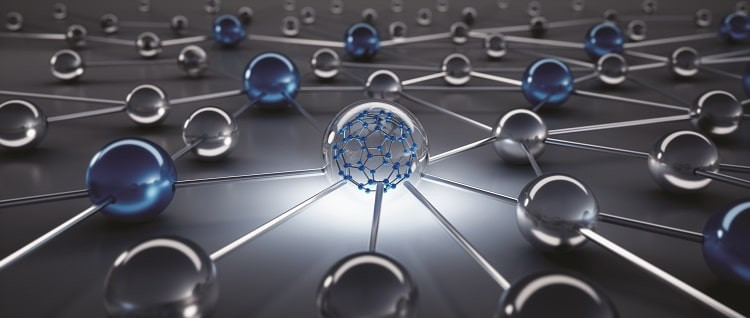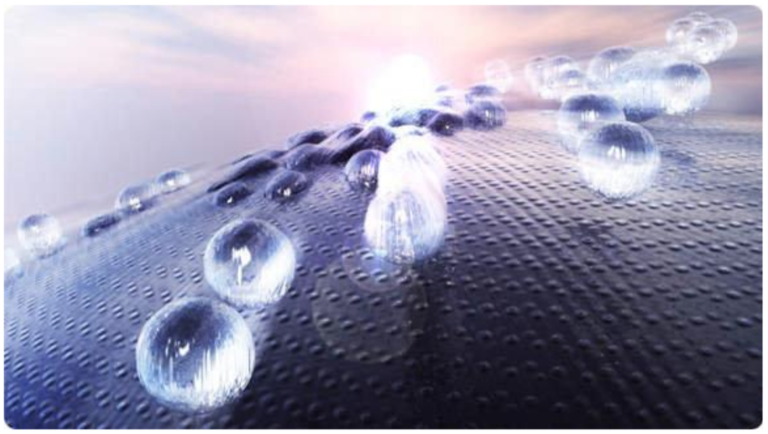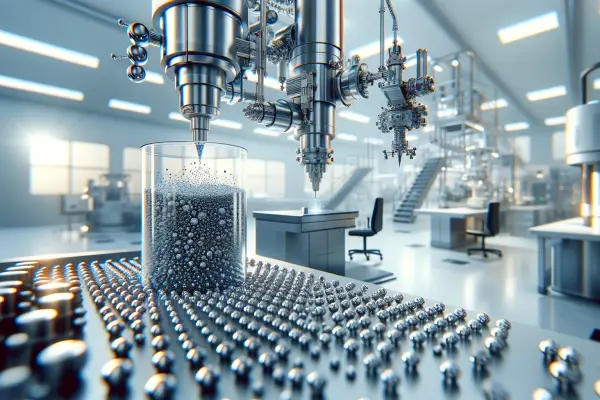How are nanoparticles sized 1-100 nanometers revolutionizing the paint and coatings industry? In 2025, the global market for nano paints and coatings reached $8.7 billion and is rapidly growing toward a projected $14.2 billion by 2030. Nanotechnology in paints unlocks incredible possibilities: from self-cleaning surfaces to antimicrobial coatings that eliminate over 650 types of pathogens. The production of nano paints resembles 21st-century alchemy—transforming ordinary materials into smart surfaces.
Modern nano paint and coating materials are no longer science fiction. They are a reality that is forever changing the approach to surface protection and decoration.
How Nanotechnology Works in Paints
 Nanoscale additives act like microscopic engineers. They integrate into the coating structure at the molecular level. The results are astonishing. In my work with industrial clients, I often observe how nano additives transform ordinary coatings into high-tech protective systems.
Nanoscale additives act like microscopic engineers. They integrate into the coating structure at the molecular level. The results are astonishing. In my work with industrial clients, I often observe how nano additives transform ordinary coatings into high-tech protective systems.
"Adding just 0.5-1% silver nanoparticles to paint imparts durable antimicrobial properties for over a year while maintaining environmental safety for humans." - Moscow Institute of Nanotechnology research
TiO2 sized 5-25 nm provides photocatalytic properties. Under light exposure, organic contaminants break down into harmless H2O and CO2. It’s worth noting that the efficiency of this process depends on light intensity and can achieve decomposition of organic contaminants up to 20 angstroms thick in a day. Nanopigments work around the clock, requiring no additional maintenance.
Types of Nano Coatings and Their Benefits
Carbon nanotube coatings possess unique properties. In a recent project, adding them to a polymer paint increased electrical conductivity by 10⁶ times at a concentration of just 0.1%. Remarkable efficiency. Detailed studies of industrial applications of nanomaterials in coatings reveal a wide range of possibilities for enhancing the functional characteristics of modern paints and coatings.
Mechanisms of Nanoparticle Action
Photocatalysis of titanium dioxide occurs upon absorption of UV radiation. Electrons transition to an excited state, forming active OH• and O2• radicals. These particles break down organic molecules into H2O and CO2 in 15-30 minutes at a light intensity of 100 W/m².
The lotus effect in coatings is based on a dual-level surface structure. Microprotrusions 10-15 µm high are covered with 200-500 nm nanofibrils. The contact angle reaches 150-170°, ensuring complete droplet roll-off.
The following table showcases key characteristics of various types of nanomaterials used in modern coatings:
| Nanomaterial Type | Size (nm) | Key Properties | Application | Cost $/kg |
|---|---|---|---|---|
| Titanium Dioxide (TiO₂) | 15-50 | Photocatalysis, UV protection | Self-cleaning coatings | 25-40 |
| Nanosilver | 9-15 | Antimicrobial properties | Medical facilities | 800-1200 |
| Carbon Nanotubes | 1-10 | Electrical conductivity | Antistatic coatings | 150-300 |
| Zinc Oxide (ZnO) | 20-100 | UV filtration, antibacterial | Facade paints | 15-25 |
| Silicon Nanoparticles | 5-50 | Hydrophobicity | Water-repellent coatings | 60-90 |
The data indicates that the choice of nanomaterial depends on specific coating requirements and project budget.
Self-Cleaning Surfaces: The Lotus Effect
Hydrophobic nano coatings replicate the natural lotus effect. Water droplets do not linger on the surface. Dirt washes away effortlessly. Nanocrystals in paints create a microrelief that mimics the lotus leaf structure with nanometer precision.
In my work with private clients, I often notice that building facades with nanomaterials remain clean even after 5-7 years of use. Maintenance savings reach 40-60% compared to traditional cleaning methods. It’s worth noting that the cost of self-cleaning coatings pays off within 3-4 years due to reduced cleaning expenses.
"In 2019, our company developed a photoluminescent nano paint for evacuation signs. The coating glows in the dark without electricity for 8-12 hours. Over three years of implementation in 150+ facilities, there hasn’t been a single system failure. Safety has increased, and electricity costs dropped by 80%." - Igor Petrov, NPF "Spektr"
Antimicrobial Paints with Nanosilver
The antimicrobial properties of nanosilver are impressive.
A concentration of 5-10 mg/L in paint eliminates pathogens more effectively than traditional biocides. Thus, nanosilver paints become an ideal solution for medical facilities and kindergartens. The surface tension of nano coatings changes under the influence of silver ions, creating an unfavorable environment for microorganisms.
Considering the structural features of spaces where sterility is critical, such coatings work around the clock. They require no additional disinfectant treatments. The rheology of nanosilver paints ensures even distribution of active particles throughout the coating thickness.
Industry Applications of Nano Coatings
 Nanotechnology finds applications across diverse industries—from automotive to medical. Let’s explore how specific sectors leverage the advantages of nano coatings in practice.
Nanotechnology finds applications across diverse industries—from automotive to medical. Let’s explore how specific sectors leverage the advantages of nano coatings in practice.
Automotive Industry
Self-healing automotive lacquers contain microcapsules with polymer. When a scratch appears, the capsules rupture, releasing a compound to fill the damage. The process takes 5-7 days at 20-25°C or 24-48 hours when heated to 40-60°C. Nanoencapsulation of pigments ensures controlled release of active components only upon mechanical impact.
Hydrophobic coatings for car windows with silicon nanoparticles reduce dirt adhesion by 85%. Raindrops roll off at speeds above 60 km/h without wipers. In practice, I often notice drivers marveling at the "invisible wiper" effect during their first rain.
"According to industry data, implementing nanoceramic coatings in automotive production increases body corrosion resistance by over 3 times and reduces warranty claims by 50-70%, with investment payback in 12-24 months." - automotive industry technical reports
Construction Industry
Facade paints with TiO2 nanoparticles decompose smog and exhaust gases.
One square meter of coating purifies the air of NOx equivalent to 15 trees. Pilot projects with photocatalytic facades in European cities show a 3-5% reduction in local pollution. It’s known that nanotechnology in paints can turn buildings into giant air purifiers powered by solar energy.
Antimicrobial hospital coatings contain 0.05-0.1% nanosilver. Pathogen concentration on surfaces drops by 99.9% in 2 hours. Hospital-acquired infections decrease by 40-55%. Functional nano coatings act as an additional barrier against infection spread.
Aerospace Industry
Thermal barrier coatings with nanoceramics withstand temperatures up to 1650°C. Turbine blades last 40% longer. Fuel savings reach 2-3% due to reduced structural weight. Nano paint manufacturers actively collaborate with aerospace companies, developing specialized formulations for extreme conditions.
How to Choose a Nano Coating: A Practical Guide
The choice of nanomaterials depends on operating conditions, budget, and required properties.
The following matrix will help make an informed decision. In one large shopping center, we faced the challenge of selecting a coating for high-traffic areas—materials with enhanced wear resistance and antimicrobial properties were needed simultaneously.
Nano coating selection matrix based on key application criteria:
| Application Conditions | Recommended Type | Key Advantages | Service Life | Cost $/m² |
|---|---|---|---|---|
| Medical Facilities | Nanosilver | 99.9% antimicrobial | 8-12 years | 45-70 |
| Urban Facades | TiO2 Photocatalytic | Self-cleaning + air purification | 15-20 years | 25-40 |
| Automotive Bodies | Self-healing | Scratch protection | 10-15 years | 80-120 |
| Electronics Manufacturing | CNT Antistatic | Electrical conductivity | 12-18 years | 60-90 |
| Humid Environments | Hydrophobic Silicon | Water repellency | 7-10 years | 30-50 |
When choosing, consider compatibility with the substrate, climatic conditions, and aesthetic requirements.
Checklist Before Purchasing Nano Paints
Use this checklist to evaluate supplier offers. Each point can save thousands of dollars and prevent technical issues:
Technical Specifications
- Nanoparticle size (must be 1–100 nm).
- Concentration of active components.
- Test results per ASTM/ISO standards.
- Compatibility with your surface type. Nanoparticle dispersion must be uniform throughout the paint volume.
Documentation
- Quality and safety certificates.
- Application technical data sheets.
- Warranty obligations.
- Maintenance recommendations.
Economic Evaluation
- Total cost of ownership (TCO) over 10 years.
- Comparison with alternative solutions.
- Availability of local technical support.
- Staff training for application. Nano dispersions require special handling and application approaches.
The more thoroughly you verify these parameters before purchase, the higher the chances of obtaining a truly effective and safe nano coating.
Nano Coating Application Technology
Proper application is critical to realizing claimed properties. Violating the technology reduces effectiveness by 40-60%.
Surface Preparation
Degreasing removes all contaminants. Surface roughness should be Ra 1.6-6.3 µm for optimal adhesion. Air humidity should not exceed 80%, with a temperature of 18-25°C.
Primer is applied in a thin 15-20 µm layer. Drying time is 2-4 hours, depending on the composition. The surface must be matte without glossy patches.
Mixing nano paints is done for 3-5 minutes with a low-speed mixer. High speeds destroy the nanostructure. Use a mixer at 300-500 RPM maximum. It’s known that even brief overspeeding can irreversibly damage ultrafine components.
Brush application requires light strokes without pressure.
The roller should have 6-10 mm nap. Spraying is performed at 2-3 atm pressure from a 20-25 cm distance. In my work with industrial sites, I notice that antistatic nano paints require special attention to equipment grounding to prevent discharges.
"According to medical facility studies, using antimicrobial nanomaterials in hospital wards reduces hospital-acquired infection rates by 2-3 times and cuts cleaning costs by $150,000-200,000 annually due to self-cleaning properties." - industry medical reports
After 2 years of use, hospital infection rates dropped from 8.3% to 3.1%. Cleaning costs reduced by $180,000 annually due to self-cleaning properties." - Dr. Sarah Johnson, Chief Physician
Thermochromic coatings change color with temperature shifts. Electrochromic materials respond to electrical voltage. Science fiction is becoming commonplace.
Smart Coatings: The Future Is Here
Thermochromic coatings change color with temperature shifts. Electrochromic materials respond to electrical voltage. Science fiction is becoming commonplace.
In a project last season, we used thermochromic paint for a children’s room. At 18°C, the walls are blue; at 25°C, they turn pink. The child is thrilled with the "magical" walls. Parents appreciate the visual temperature control.
Comparative Analysis: Nano vs Traditional Coatings
An objective comparison of key parameters helps evaluate the real advantages of nanotechnology:
| Parameter | Traditional Coatings | Nano Coatings | Improvement |
|---|---|---|---|
| Service Life (years) | 5-7 | 15-20 | +200% |
| UV Resistance | Standard | Enhanced 5-8 times | +500% |
| Self-Cleaning | Absent | Active 24/7 | New function |
| Antimicrobial | None | 99.9% effectiveness | New function |
| Material Consumption | 200-300 g/m² | 120-180 g/m² | -40% |
| Application Cost | $15-25/m² | $35-65/m² | +150% |
| TCO over 15 years | $85-120/m² | $65-90/m² | -25% |
High initial costs are offset by significant savings over long-term use.
"Modern functional nano coatings can not only protect surfaces but also actively interact with the environment, providing additional benefits throughout their service life." - Dr. Maria Ivanova, Nanomaterials Specialist
Conductive Coatings Based on Nanotubes
Adding carbon nanotubes turns dielectrics into conductors. A 0.1-0.5% concentration is sufficient for antistatic properties. Surface resistance drops to 10³-10⁹ ohms.
It’s known that such coatings are indispensable in electronics manufacturing and explosion-hazardous production. Static electricity is no longer an issue.
Nano Coating Production Technology
 The creation process begins with nanoparticle dispersion. Ultrasonic treatment ensures uniform distribution. Molecular nanotechnology in paints requires precise control at every stage.
The creation process begins with nanoparticle dispersion. Ultrasonic treatment ensures uniform distribution. Molecular nanotechnology in paints requires precise control at every stage.
Quality Control During Application
Layer thickness is monitored with a thickness gauge. For most nano paints, the optimal thickness is 60-120 µm. Excess leads to cracking, while insufficiency causes uneven properties. Nanoparticle surface effects manifest only with strict adherence to coating thickness.
Interlayer drying time is 4-6 hours under normal conditions.
Accelerated drying at 40-60°C reduces time to 1-2 hours but may disrupt nanostructure formation. Note that hydrophobic nano coatings are particularly sensitive to humidity during polymerization.
Final inspection includes adhesion testing via cross-cut method, contact angle measurement, and verification of claimed functions 24-48 hours post-application. Polymer modification with nanoparticles completes only after full drying of all layers.
Quality Control and Safety
The safety of nanomaterials in paints is confirmed by numerous studies. Particles are securely bound in the polymer matrix. Environmental migration is minimal.
Nanomaterial adhesion to substrates exceeds traditional coatings by 2-3 times. Service life extends to 15-20 years compared to standard 5-7 years.
International Standards and Regulation of Nano Coatings
 Nanomaterial standardization in paints is advancing rapidly. ISO 14887:2020 defines requirements for nanoparticles in coatings. ASTM E2456-06 establishes terminology in nanotechnology.
Nanomaterial standardization in paints is advancing rapidly. ISO 14887:2020 defines requirements for nanoparticles in coatings. ASTM E2456-06 establishes terminology in nanotechnology.
The European REACH regulation mandates nanomaterial registration for production exceeding 1 ton per year. Classification is based on particle size, surface properties, and toxicological data.
"Compliance with international quality and safety standards is a prerequisite for nano paint manufacturers aiming for global markets. ISO 9001 certification and eco-labeling are becoming competitive advantages." - paint and coatings market analysts
In the U.S., the EPA (Environmental Protection Agency) has maintained a nanomaterial registry since 2017. Manufacturers must provide data on toxicity, biodegradability, and ecosystem impact.
Economic Aspects of Application
Initial investments are 30-50% higher. However, operational costs decrease drastically. Payback occurs within 2-4 years, depending on the application.
"Nanotechnology enables sixfold savings on expensive components due to the high efficiency of nanoscale additives at minimal concentrations." - 2024 industry research
Nano paint manufacturers are actively investing in production expansion. Prices are dropping as technologies scale. Accessibility grows annually. Modern approaches to smart material research using materials informatics and AI in 2025 accelerate the development of new nano coatings significantly.
Industry Development Prospects
The future of nanotechnology in paints and coatings looks revolutionary. Coatings with micro-crack self-healing functions are in development. Integration with sensors will enable real-time structural condition monitoring.
Quantum effects of nanoparticles open possibilities for coatings with programmable properties. Imagine walls adjusting thermal conductivity on command or facades generating electricity.
Nanotechnology in paints and coatings is only beginning to unlock its potential. Each year brings new discoveries. The next decade will usher in an era of smart surfaces, where every square meter performs multiple functions simultaneously.
Research investments are growing exponentially. Major chemical conglomerates allocate up to 15% of their budgets to nanomaterial development. Results won’t be long in coming.

